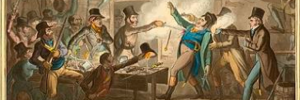The depiction of clay pipes in English art, particularly in London, is a vivid representation of the significant role these objects played in the social and cultural life of the Georgian and Victorian periods. Used as an everyday object, a status symbol, and an emblem of camaraderie and contemplation, clay pipes became a popular motif that lent authenticity, character, and narrative depth to artistic works of the time.
In the Georgian era, the golden age of the clay pipe, the streets of London teemed with the imagery of people indulging in their tobacco. This scene was not lost on contemporary artists who often featured the clay pipe in their paintings to convey a sense of realism and everyday life. In tavern scenes or depictions of public houses, clay pipes were a common sight, accentuating the atmosphere of shared experiences and companionship.
A notable example is the work of artist and social commentator William Hogarth. His series of paintings and engravings, such as “A Rake’s Progress” and “Beer Street,” often showcased characters with clay pipes. Hogarth used the clay pipe not just as a representation of ordinary life but also as a symbol of the moral and social narratives he was portraying.
As we move into the Victorian era, the depiction of clay pipes in art began to change. The advent of photography, with its capacity for capturing minute detail, saw a multitude of images featuring individuals or groups with their pipes. Clay pipes also figured prominently in the sentimental and genre paintings of the period, often used to signify a character’s profession or social standing.
Clay pipes also found their way into the political cartoons and satirical sketches that were growing increasingly popular during this era. They were a quick visual shorthand for the common man, working classes, or the ‘salt of the earth’ type characters.
While the prevalence of clay pipes in artwork dwindled with their use, their appearance still symbolises a particular time and social context. Whether held by a weary worker in a genre painting, gripped by a figure in a boisterous tavern scene, or clutched by a contemplative gentleman in a portrait, the clay pipe stands as a testament to the societal norms and personal narratives of the time. It serves as a powerful symbol, a miniature monument to a bygone era and its social customs.
The depiction of clay pipes in English art, particularly in the works produced in London, offers fascinating insights into societal norms, cultural practices, and the lived experience of individuals in the Georgian and Victorian periods. These seemingly simple objects, when viewed through the lens of art history, reveal a layered and nuanced understanding of the past.



